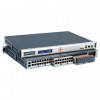Lantronix SLC 8000 Advanced Console Manager User Guide - Page 272
Optimizing and Troubleshooting RPM Behavior, Sentry3 - Network and Serially Managed PDUs
 |
View all Lantronix SLC 8000 Advanced Console Manager manuals
Add to My Manuals
Save this manual to your list of manuals |
Page 272 highlights
10: Remote Power Managers Optimizing and Troubleshooting RPM Behavior This section gives tips on how to optimize the management of specific PDUs and UPSes, and how to troubleshoot any problems with the SLC connecting to and managing an RPM. Sentry3 - Network and Serially Managed PDUs - Some Sentry3 PDUs have a CLI timeout, with a default setting of 5 minutes. This timeout may cause frequent query errors when requesting information from the Sentry3 PDU. It is recommended that the timeout be set as high as possible to reduce the frequency of the query errors. Serially Managed RPMs with Administrator Logins - Some serially managed devices will have an administrator login for the console port. It is recommended that any active sessions be logged out before adding the device as an RPM, otherwise the RPM may experience query errors. If the SLC is unable to communicate with an RPM, or an RPM is displaying the error "driver is not running", the following steps can be used to troubleshoot the driver issues: Correct Driver - The CLI command set rpm driver action show can be used to display the current running driver for the RPM. Some serially and network managed RPMs do not have drivers; if this is the case for the RPM, the CLI command will indicate this. Otherwise it will display the driver that is running for the RPM, and it should match the driver listed for the device at Network UPS Tools Hardware Compatibility List. If the wrong driver is shown, the RPM will need to be deleted and re-added, with the correct vendor and model selected. If no driver is shown, the driver may not be able to start for a variety of reasons; see remaining steps. SNMP Settings - For SNMP managed devices, verify the IP Address, Read Community and Write Community settings are correct. Reverse Pinout Setting - For serially managed devices, verify the Reverse Pinout setting (located in the Device Port Settings page) is set correctly. VendorId and ProductId Driver Options - For USB managed devices, verify the vendorid and productid shown in the RPM driver options are correct. These can be set automatically by the SLC from an internal table, set by the user by selecting a specific USB device when adding a USB-managed RPM, or changed by the user at any time. The CLI command show usb devices displays all connected USB devices with their port, Product ID and Vendor ID. Extra Driver Options - The driver documentation at Network UPS Tools Hardware Compatibility List may indicate that extra driver options are required for the RPM. Select the driver name link under the Driver column to see any special requirements for the UPS or PDU. Driver Debug Mode - The driver can be run in debug mode at the CLI and the output examined to determine why the driver is not starting or is unable to communicate with the RPM. The CLI command set rpm driver action debug [level ] will stop any currently running driver and restart the driver in debug mode with output sent to a local file. Running set rpm driver action show should show a driver running with one or more -D flags. The debug output can be examined or emailed with the set rpm driver action viewoutput [email ] [display ] [numlines ] command. To return the driver to its normal non-debug state, run set rpm driver action restart. Note that drivers running in debug mode will generate copious output, and for disk space reasons should not be left running in debug mode for long periods of time (e.g. more than an hour). SLC™ 8000 Advanced Console Manager User Guide 272















